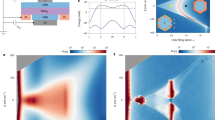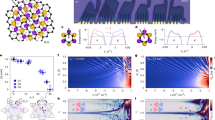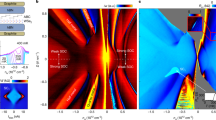Abstract
The discovery of superconductivity in twisted bilayer and trilayer graphene1,2,3,4,5 has generated tremendous interest. The key feature of these systems is an interplay between interlayer coupling and a moiré superlattice that gives rise to low-energy flat bands with strong correlations6. Flat bands can also be induced by moiré patterns in lattice-mismatched and/or twisted heterostructures of other two-dimensional materials, such as transition metal dichalcogenides (TMDs)7,8. Although a wide range of correlated phenomena have indeed been observed in moiré TMDs9,10,11,12,13,14,15,16,17,18,19, robust demonstration of superconductivity has remained absent9. Here we report superconductivity in 5.0° twisted bilayer WSe2 with a maximum critical temperature of 426 mK. The superconducting state appears in a limited region of displacement field and density that is adjacent to a metallic state with a Fermi surface reconstruction believed to arise from AFM order20. A sharp boundary is observed between the superconducting and magnetic phases at low temperature, reminiscent of spin fluctuation-mediated superconductivity21. Our results establish that moiré flat-band superconductivity extends beyond graphene structures. Material properties that are absent in graphene but intrinsic among TMDs, such as a native band gap, large spin–orbit coupling, spin-valley locking and magnetism, offer the possibility of accessing a broader superconducting parameter space than graphene-only structures.
This is a preview of subscription content, access via your institution
Access options
Access Nature and 54 other Nature Portfolio journals
Get Nature+, our best-value online-access subscription
$32.99 / 30 days
cancel any time
Subscribe to this journal
Receive 51 print issues and online access
$199.00 per year
only $3.90 per issue
Buy this article
- Purchase on SpringerLink
- Instant access to full article PDF
Prices may be subject to local taxes which are calculated during checkout




Similar content being viewed by others
Data availability
The data relevant to figures in the main text are available via Zenodo at https://doi.org/10.5281/zenodo.13910339 (ref. 56). Additional raw data are available from the corresponding author on reasonable request.
References
Cao, Y. et al. Unconventional superconductivity in magic-angle graphene superlattices. Nature 556, 43–50 (2018).
Yankowitz, M. et al. Tuning superconductivity in twisted bilayer graphene. Science 363, 1059–1064 (2019).
Lu, X. et al. Superconductors, orbital magnets and correlated states in magic-angle bilayer graphene. Nature 574, 653–657 (2019).
Park, J. M., Cao, Y., Watanabe, K., Taniguchi, T. & Jarillo-Herrero, P. Tunable strongly coupled superconductivity in magic-angle twisted trilayer graphene. Nature 590, 249–255 (2021).
Hao, Z. et al. Electric field–tunable superconductivity in alternating-twist magic-angle trilayer graphene. Science 371, 1133–1138 (2021).
Bistritzer, R. & MacDonald, A. H. Moiré bands in twisted double-layer graphene. Proc. Natl Acad. Sci. USA 108, 12233–12237 (2011).
Wu, F., Lovorn, T., Tutuc, E. & MacDonald, A. H. Hubbard model physics in transition metal dichalcogenide moiré bands. Phys. Rev. Lett. 121, 026402 (2018).
Naik, M. H. & Jain, M. Ultraflatbands and shear solitons in moiré patterns of twisted bilayer transition metal dichalcogenides. Phys. Rev. Lett. 121, 266401 (2018).
Wang, L. et al. Correlated electronic phases in twisted bilayer transition metal dichalcogenides. Nat. Mater. 19, 861–866 (2020).
Tang, Y. et al. Simulation of Hubbard model physics in WSe2/WS2 moiré superlattices. Nature 579, 353–358 (2020).
Anderson, E. et al. Programming correlated magnetic states via gate controlled moiré geometry. Science 381, 325–330 (2023).
Regan, E. C. et al. Mott and generalized Wigner crystal states in WSe2/WS2 moiré superlattices. Nature 579, 359–363 (2020).
Li, H. et al. Imaging two-dimensional generalized Wigner crystals. Nature 597, 650–654 (2021).
Xu, Y. et al. Correlated insulating states at fractional fillings of moiré superlattices. Nature 587, 214–218 (2020).
Li, T. et al. Quantum anomalous Hall effect from intertwined moiré bands. Nature 600, 641–646 (2021).
Cai, J. et al. Signatures of fractional quantum anomalous Hall states in twisted MoTe2 bilayer. Nature 622, 63–68 (2023).
Zeng, Y. et al. Thermodynamic evidence of fractional Chern insulator in moiré MoTe2. Nature 622, 69–73 (2023).
Park, H. et al. Observation of fractionally quantized anomalous Hall effect. Nature 622, 74–79 (2023).
Foutty, B. A. et al. Mapping twist-tuned multiband topology in bilayer WSe2. Science 384, 343–347 (2024).
Ghiotto, A. et al. Stoner instabilities and Ising excitonic states in twisted transition metal dichalcogenides. Preprint at https://arxiv.org/abs/2405.17316 (2024).
Mathur, N. D. et al. Magnetically mediated superconductivity in heavy fermion compounds. Nature 394, 39–43 (1998).
Sharpe, A. L. et al. Emergent ferromagnetism near three-quarters filling in twisted bilayer graphene. Science 365, 605–608 (2019).
Serlin, M. et al. Intrinsic quantized anomalous Hall effect in a moiré heterostructure. Science 367, 900–903 (2020).
Zhou, H., Xie, T., Taniguchi, T., Watanabe, K. & Young, A. F. Superconductivity in rhombohedral trilayer graphene. Nature 598, 434–438 (2021).
Zhou, H. et al. Isospin magnetism and spin-polarized superconductivity in Bernal bilayer graphene. Science 375, 774–778 (2022).
Zhang, Y. et al. Enhanced superconductivity in spin–orbit proximitized bilayer graphene. Nature 613, 268–273 (2023).
Li, C. et al. Tunable superconductivity in electron- and hole-doped Bernal bilayer graphene. Nature 631, 300–306 (2024).
Venderley, J. & Kim, E.-A. Density matrix renormalization group study of superconductivity in the triangular lattice Hubbard model. Phys. Rev. B 100, 060506 (2019).
Hsu, Y.-T., Wu, F. & Das Sarma, S. Spin-valley locked instabilities in moiré transition metal dichalcogenides with conventional and higher-order Van Hove singularities. Phys. Rev. B 104, 195134 (2021).
Schrade, C. and Fu, L. Nematic, chiral and topological superconductivity in transition metal dichalcogenides. Phys. Rev. B 110, 035143 (2024).
Crépel, V., Guerci, D., Cano, J., Pixley, J. H. & Millis, A. Topological superconductivity in doped magnetic moiré semiconductors. Phys. Rev. Lett. 131, 056001 (2023).
Klebl, L., Fischer, A., Classen, L., Scherer, M. M. & Kennes, D. M. Competition of density waves and superconductivity in twisted tungsten diselenide. Phys. Rev. Res. 5, L012034 (2023).
Zhou, B. & Zhang, Y.-H. Chiral and nodal superconductors in the t–J model with valley contrasting flux on a triangular moiré lattice. Phys. Rev. B 108, 155111 (2023).
Zegrodnik, M. & Biborski, A. Mixed singlet-triplet superconducting state within the moiré t–J–U model applied to twisted bilayer WSe2. Phys. Rev. B 108, 064506 (2023).
Pack, J. et al. Charge-transfer contacts for the measurement of correlated states in high-mobility WSe2. Nat. Nanotechnol. 19, 948–954 (2024).
Yankowitz, M. et al. Emergence of superlattice Dirac points in graphene on hexagonal boron nitride. Nat. Phys. 8, 382–386 (2012).
Beasley, M. R., Mooij, J. E. & Orlando, T. P. Possibility of vortex-antivortex pair dissociation in two-dimensional superconductors. Phys. Rev. Lett. 42, 1165–1168 (1979).
Zang, J., Wang, J., Cano, J. & Millis, A. J. Hartree-Fock study of the moiré Hubbard model for twisted bilayer transition metal dichalcogenides. Phys. Rev. B 104, 075150 (2021).
Crépel, V. & Millis, A. Bridging the small and large in twisted transition metal dicalcogenide homobilayers: A tight binding model capturing orbital interference and topology across a wide range of twist angles. Phys. Rev. Res. 6, 033127 (2024).
Liu, X. et al. Tuning electron correlation in magic-angle twisted bilayer graphene using Coulomb screening. Science 371, 1261–1265 (2021).
Holleis, L. et al. Nematicity and orbital depairing in superconducting Bernal bilayer graphene with strong spin orbit coupling. Preprint at https://arxiv.org/abs/2303.00742 (2023).
Yang, Z., Lange, M., Volodin, A., Szymczak, R. & Moshchalkov, V. V. Domain-wall superconductivity in superconductor–ferromagnet hybrids. Nat. Mater. 3, 793–798 (2004).
Mukherjee, A. et al. Superconducting magic-angle twisted trilayer graphene hosts competing magnetic order and moiré inhomogeneities. Preprint at https://arxiv.org/abs/2406.02521 (2024).
Bardeen, J., Cooper, L. N. & Schrieffer, J. R. Theory of superconductivity. Phys. Rev. 108, 1175–1204 (1957).
Balents, L., Dean, C. R., Efetov, D. K. & Young, A. F. Superconductivity and strong correlations in moiré flat bands. Nat. Phys. 16, 725–733 (2020).
Wu, F., MacDonald, A. H. & Martin, I. Theory of phonon-mediated superconductivity in twisted bilayer graphene. Phys. Rev. Lett. 121, 257001 (2018).
Fischer, A., Klebl, L., Honerkamp, C. & Kennes, D. M. Spin-fluctuation-induced pairing in twisted bilayer graphene. Phys. Rev. B 103, L041103 (2021).
Zhai, H., Wang, F. & Lee, D.-H. Antiferromagnetically driven electronic correlations in iron pnictides and cuprates. Phys. Rev. B 80, 064517 (2009).
Scalapino, D. J. A common thread: the pairing interaction for unconventional superconductors. Rev. Mod. Phys. 84, 1383–1417 (2012).
Xia, Y. et al. Superconductivity in twisted bilayer WSe2. Nature https://doi.org/10.1038/s41586-024-08116-2 (2024).
Wang, L. et al. One-dimensional electrical contact to a two-dimensional material. Science 342, 614–617 (2013).
Sternbach, A. J. et al. Quenched excitons in WSe2/α-RuCl3 heterostructures revealed by multimessenger nanoscopy. Nano Lett. 23, 5070–5075 (2023).
Xie, J. et al. Low resistance contact to P-type monolayer WSe2. Nano Lett. 24, 5937–5943 (2024).
Liu, S. et al. Two-step flux synthesis of ultrapure transition-metal dichalcogenides. ACS Nano 17, 16587–16596 (2023).
Kim, K. et al. Van der Waals heterostructures with high accuracy rotational alignment. Nano Lett. 16, 1989–1995 (2016).
Guo, Y. Data related to “Superconductivity in 5.0° twisted bilayer WSe2”. Zenodo https://doi.org/10.5281/zenodo.13910339 (2024).
Acknowledgements
This research on superconductivity in tWSe2 structures is solely supported as part of Programmable Quantum Materials, an Energy Frontier Research Center funded by the US Department of Energy, Office of Science, Basic Energy Sciences, under award no. DE-SC0019443. WSe2 was synthesized by J.H. and K.B. with the support of the Columbia University Materials Science and Engineering Research Center, through NSF grant no. DMR-2011738. D.G.M. and M.C. acknowledge support from the Gordon and Betty Moore Foundation’s EPiQS Initiative (grant no. GBMF9069). K.W. and T.T. acknowledge support from JSPS KAKENHI (grant nos. 21H05233 and 23H02052) and the World Premier International Research Center Initiative, MEXT, Japan. J.H. and C.R.D. acknowledge additional support from the Gordon and Betty Moore Foundation’s EPiQS Initiative (grant no. GBMF10277).
Author information
Authors and Affiliations
Contributions
Y.G. fabricated the device. Y.G., J.P., J.S. and C.R.D. performed electronic transport measurements and analysed data. L.H. grew WSe2 crystals under the supervision of J.H. and K.B. M.C. grew α-RuCl3 crystals under the supervision of D.G.M. K.W. and T.T. grew hexagonal boron nitride crystals. A.M. performed theoretical modelling. Y.G., A.J.M., A.P. and C.R.D. wrote the manuscript, with input from all authors.
Corresponding author
Ethics declarations
Competing interests
The authors declare no competing interests.
Peer review
Peer review information
Nature thanks Sergio de la Barrera, Zheng Zhu and the other, anonymous, reviewer(s) for their contribution to the peer review of this work.
Additional information
Publisher’s note Springer Nature remains neutral with regard to jurisdictional claims in published maps and institutional affiliations.
Supplementary information
Supplementary Information
Supplementary Figs. 1–15 and references.
Rights and permissions
Springer Nature or its licensor (e.g. a society or other partner) holds exclusive rights to this article under a publishing agreement with the author(s) or other rightsholder(s); author self-archiving of the accepted manuscript version of this article is solely governed by the terms of such publishing agreement and applicable law.
About this article
Cite this article
Guo, Y., Pack, J., Swann, J. et al. Superconductivity in 5.0° twisted bilayer WSe2. Nature 637, 839–845 (2025). https://doi.org/10.1038/s41586-024-08381-1
Received:
Accepted:
Published:
Issue date:
DOI: https://doi.org/10.1038/s41586-024-08381-1
This article is cited by
-
Optical properties, plasmons, and orbital Skyrme textures in twisted TMDs
npj Quantum Materials (2025)
-
Experimental signature of layer skyrmions and implications for band topology in twisted WSe2 bilayers
Nature Physics (2025)
-
Moiré materials based on M-point twisting
Nature (2025)
-
Correlated states controlled by a tunable van Hove singularity in moiré WSe2 bilayers
Nature Communications (2025)
-
Superconductivity and quantized anomalous Hall effect in rhombohedral graphene
Nature (2025)



